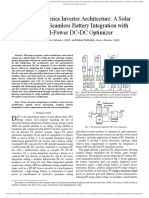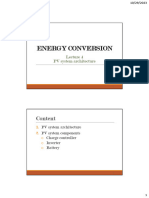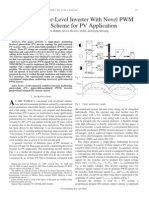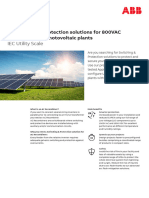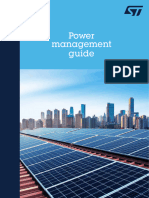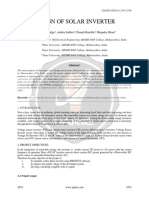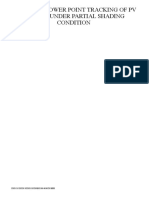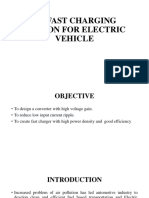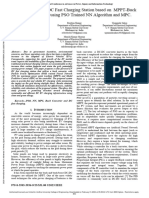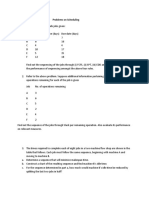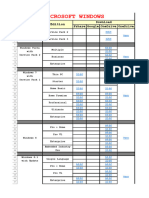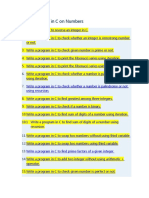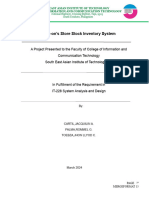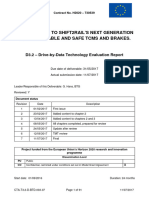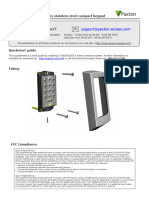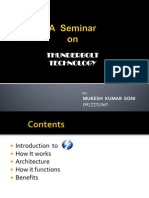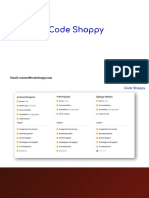www.ti.
com Table of Contents
Application Note
Power Topology Considerations for Solar String Inverters
and Energy Storage Systems
Vedatroyee Ghosh, Harald Parzhuber
ABSTRACT
As PV solar installations continue to grow rapidly over the last decade, the need for solar inverters with high
efficiency, improved power density and higher power handling capabilities continue to increase. Today this is
state of the art that these systems have a power conversion system (PCS) for battery storage integrated.
This application note outlines the most relevant power topology considerations for designing power stages
commonly used in Solar Inverters and Energy Storage Systems (ESS).
Table of Contents
1 Introduction.............................................................................................................................................................................2
2 Solar String Inverters............................................................................................................................................................. 2
2.1 Power Stages for DC/DC MPPT........................................................................................................................................ 2
2.2 Power Stages for Battery Port DC/DC............................................................................................................................... 3
2.3 Power Stages for Single-Phase DC/AC............................................................................................................................. 5
2.4 Power Stages for Three-Phase DC/AC..............................................................................................................................7
3 Future Technology and Trends..............................................................................................................................................8
4 Summary................................................................................................................................................................................. 9
5 References.............................................................................................................................................................................. 9
6 Revision History................................................................................................................................................................... 10
List of Figures
Figure 2-1. Solar String Inverter Block Diagram.......................................................................................................................... 2
Figure 2-2. DC/DC MPPT Stage Block Diagram......................................................................................................................... 3
Figure 2-3. DC/DC Stage for Battery Block Diagram...................................................................................................................4
Figure 2-4. Single-Phase DC/AC Stage Block Diagram.............................................................................................................. 5
Figure 2-5. Schematic Representation of Three-phase DC/AC Topologies................................................................................ 7
List of Tables
Table 2-1. Benefits and Challenges of Single-Phase DC/AC Topologies.................................................................................... 6
Table 2-2. Benefits and Challenges of Three-phase DC/AC Topologies..................................................................................... 7
Trademarks
All trademarks are the property of their respective owners.
SLLA498A – OCTOBER 2020 – REVISED DECEMBER 2024 Power Topology Considerations for Solar String Inverters and Energy Storage 1
Submit Document Feedback Systems
Copyright © 2024 Texas Instruments Incorporated
�Introduction www.ti.com
1 Introduction
Solar string inverters are used to convert the DC power output from a string of solar panels to an AC
power. String inverters are commonly used in residential and smaller commercial installations. Wide bandgap
semiconductors like Silicon carbide (SiC) and Gallium nitride (GaN) allow to operate converters at higher
switching frequencies which allows use of smaller magnetic components and in turn drive power density of these
systems up. To scale power levels up very often such systems are made in modular fashion to get from 10th of
kW to 100th of kWs.
To cope with the fact that Photovoltaic (PV)-systems stop generating energy when sun light goes down, these
systems very often incorporate a power conversion port for a battery energy storage system (BESS). Excess
energy generated during day time is stored into the battery and can be used during times the energy from the
PV-string is not enough.
2 Solar String Inverters
Figure 2-1 shows the typical architecture of a solar string inverter.
Bi-directional Bi-directional DC/DC
PFC/Inverter
AC Bus
DC Charge/Discharge
1ph-110/230VAC
AC
3ph-400VAC 100-800V
DC
400V or 800VDC
DC Charger DC/DC
Control Loop
PCC
DC Bus
Uni-directional DC/DC
Point of Common with MPPT
Coupling
PV #1 PV #2 PV #3 PV #n
DC String 1
DC I = 16AMAX
Up to 1000VDC
Boost DC/DC &
MPPT Uni-directional DC/DC
PFC/Inverter Control Loop with MPPT
Control Loop
PV #1 PV #2 PV #3 PV #n
DC String 1
I = 16AMAX
DC Up to 1000VDC
Control
Control MCU
(multiple)
or Control MPU
Figure 2-1. Solar String Inverter Block Diagram
As Figure 2-1 illustrates, there are three major power blocks in the string inverter. The first stage is a uni-
directional DC/DC converter stage that converts the variable string output to a stable high-voltage DC link
suitable for the next stages, the second is a bidirectional DC/DC power stage the third a bidirectional DC/AC
inverter stage. For single-phase systems the DC Bus voltage is typically 400VDC. For three-phase systems the
DC-Bus voltage is around 800VDC or even higher up to 1500VDC. This first DC/DC stage is also able to perform
the Maximum Power Point Tracking (MPPT) for a complete string. It simply searches for the maximum power
by changing voltage and current across a complete string. This DC Bus voltage is then converted to an AC
voltage at the grid voltage level by the DC/AC inverter power stage. In today’s systems, the AC/DC is built as
bidirectional PFC/Inverter to allow the operation of the DC/DC power stage that connects to a battery energy
storage system, and allows to charge and discharge the ESS in both directions.
A more detailed block diagram of Solar String inverter is available on TI's String inverter applications page.
2.1 Power Stages for DC/DC MPPT
The MPPT DC/DC power stage performs the function of translating multiples of MPPT voltage of a panel
(depending on the number of panels in a string) to a stable voltage level suitable for the inverter or DC/DC stage
for battery input. The input voltage is regulated by MPPT which is either performed through software or through
external add-ons like a power optimizer. A PV panel acts as a current source where the short circuit current is
2 Power Topology Considerations for Solar String Inverters and Energy Storage SLLA498A – OCTOBER 2020 – REVISED DECEMBER 2024
Systems Submit Document Feedback
Copyright © 2024 Texas Instruments Incorporated
�www.ti.com Solar String Inverters
approximately proportional to the irradiation available. The open circuit voltage across a PV panel is dependent
on the ambient temperature conditions. For residential use cases, PV panels usually depict an output MPPT
voltage of 33V for a 400W panel and 40V or higher for 500W or 600W rated panels.
Since a string inverter is a cost-sensitive application, a non-isolated boost converter is the preferred topology for
conversion of the input string voltage to a stable DC link voltage. Figure 2-2 depicts such an example present in
TIDA-010938. This input voltage exists as multiples of 33V or 40V depending on the type and wattage of panels
used. The DC link voltage can vary depending on whether it is a single-phase application or a three-phase
application. For single-phase, the bus can be rated up to 500-550V and for three-phase usually up to 1200V.
A buck or buck-boost stage will be less efficient due to the higher current to be supported with a lower DC
link voltage. To increase power level of this stage, multiple strings can be added as independent inputs. Each
input can be designed independently and symmetrically. Usually a CLLLC stage or synchronous boost is not
employed here since it will not be cost effective.
DC/DC Boost with MPPT2
DC/DC Boost with MPPT1
String 2 Input range: 50-500V
String 1 ISC: 18A
VPV Max. DC current: 14A
PWM1 Q1
I-Sensor
INA181
IA
Figure 2-2. DC/DC MPPT Stage Block Diagram
A boost converter needs one controlled switch (MOSFET, IGBT, etc) in combination with an uncontrolled switch
(diode) and an inductor to realize it. This topology has several benefits such as lower number of components,
high efficiency, simple implementation, etc. At higher power levels, the diode is replaced by another controlled
switch (used as a synchronous switch) to reduce conduction losses. Thus it becomes the synchronous boost
converter.
With even higher power levels (as encountered in string inverters), we end up paralleling the power devices
so as to reduce conduction losses. Multiple stages of synchronous boost converters are used with phase-
interleaved PWMs driving each converter. For ‘n’ number of interleaved stages, the phase difference between
the individual PWMs is 360° /n. This significantly reduces ripple currents and helps reduce the overall size.
It is important to keep in mind that the switching transistors need to be appropriately rated depending on the type
of application. This translates to 650V drain-source voltage rating for single-phase and up to 1200V rating for
three-phase applications (higher drain-source voltage rating required for systems with higher DC bus voltage).
Going higher with DC link voltage to beyond 1000V will reduce power losses in system and allow more panels to
be added in series. However, the devices need to be chosen with appropriate ratings.
2.2 Power Stages for Battery Port DC/DC
For non-isolated applications, a bidirectional DC/DC converter can be used to have the possibility of battery
energy storage system (BESS). Bi-directionality is important for the DC/DC converter to act like a battery charger
(in buck mode) and discharging the battery (in boost mode) to provide a higher and stable output voltage at
the DC link. This can then be transferred into AC power towards the grid by means of a DC/AC converter in
conditions like low irradiance scenarios or night-time conditions.
Solar energy has daily, seasonal and yearly fluctuations, so it is not the most reliable source. In a grid connected
system, maximum power is delivered to the grid during noon, while in the morning and evening it is less. In many
regions world-wide, the price of power is demand-dependent – the price (cost per watt) is higher when demand
is high (like evenings and mornings), and it is lower when demand is low (noon, late night). So a consumer with
SLLA498A – OCTOBER 2020 – REVISED DECEMBER 2024 Power Topology Considerations for Solar String Inverters and Energy Storage 3
Submit Document Feedback Systems
Copyright © 2024 Texas Instruments Incorporated
�Solar String Inverters www.ti.com
solar installation gets a lower price for the power he produces during the noon time, while paying higher for the
power he consumes off the grid in the evening. Also, if there is any fault in the grid, all the power produced goes
to waste as the grid is not accessible. Due to such issues, the trend is to have some local energy storage so that
energy can be stored and released to the grid when it is accessible and when demand is high.
To increase the power level of this stage and to reduce the current ripple, interleaving of branches can be carried
out. Interleaving helps in reducing output current ripple, output noise, decrease of the size of the EMI filter, and
increase power density. It is relatively simple to implement and control, however for optimum performance it is
recommended to have the interleaved half-bridges as symmetrical as possible, to have balanced current flow
between the them. Such multiphase designs also enable multiples of switching frequency across the output
EMI filter, thus making the design smaller. A typical application of such a non-isolated topology can be seen in
TIDA-010938 in Figure 2-3. Here, we can see two interleaved stages with an applied phase difference of 180 o
between each other.
VDC+ (Max 520V)
Bidirectional interleaved DC/DC
Battery Voltage: 50V-500V
Max charge current: 30A
Max discharge current: 30A
Q3 PWM3 Q5 PWM5
I-Sensor
I-Sensor
Q2 Q4
+ VBAT
PWM2 PWM4
IC
AMC1302
– IB AMC1302
VDC– IB’ IC’
Figure 2-3. DC/DC Stage for Battery Block Diagram
Isolation comes into play when we talk about systems relating to automotive applications or battery with lower
voltage ratings. Most popular topologies in this regard include the Dual Active Bridge with Extended Phase Shift
(for example in TIDA-010054) which deals with a primary voltage of 700V to 800V DC, and secondary voltage
of 350V to 500V DC (single-phase-shift SPS) or 250V to 500V (extended-phase-shift EPS) for power levels up
to 10 kW, Phase-shifted Full-Bridge (for example in PMP22951) which deals with a voltage of 400V down to
54V and a power level of 3kW or CLLLC Dual-Active Bridge (for example in TIDM-02002) which deals with a
primary voltage range of 380–600V to a secondary voltage range of 280–450V and power levels up to 6.6kW.
Depending on whether it is a three-phase or a single-phase application, the drain-source voltage rating of the
devices would change. This translates to 650V drain-source voltage rating for single-phase and up to 1200V
rating for three-phase application (higher drain-source voltage rating required for systems with higher DC bus
voltage).
Though Lead-acid type batteries are very popular in energy storage systems, newer systems are increasingly
moving to various types of Lithium batteries. The battery voltage depends upon the system power level. Lower
power single phase systems commonly use 48V battery, while higher power three phase systems use 400V
battery. Systems with even higher power range of string inverters could use 800V battery for storage. This may
vary depending on the application and use case.
A more detailed block diagram of Energy Storage Power Conversion System is available on TI's Energy storage
power conversion system (PCS) applications page.
4 Power Topology Considerations for Solar String Inverters and Energy Storage SLLA498A – OCTOBER 2020 – REVISED DECEMBER 2024
Systems Submit Document Feedback
Copyright © 2024 Texas Instruments Incorporated
�www.ti.com Solar String Inverters
2.3 Power Stages for Single-Phase DC/AC
The inverter power stage is kept bidirectional to enable power conversion from DC link into grid compatible
AC power and vice versa. State of the art string inverters tend to be grid-tied and synchronized to the grid at
all times via Phase-Locked Loop (PLL). The inverter or PFC stage can be divided into two broad categories
namely whether the grid is single-phase or three-phase. Single-phase further dictates the rating of the devices
on whether it is split-phase (110VRMS in Japan, the USA etc) or 230VRMS (in Europe, ROA, and so on).
A grid-tied inverter has the additional task of synchronizing in amplitude, frequency, and phase with the existing
grid comprised of multiple sources and loads. It also needs to address the situation of detecting and isolating
itself from the grid in the event of any faults in the grid like black-out, brown-out, overvoltage, and so forth. This is
called anti-islanding protection.
Present-day string inverters which tend to be cost and power density competitive are generally transformer-less
in nature. Transformer-less string inverters present low impedance paths for return currents. This leakage
current is a well-known challenge in PV applications due to PV surfaces exposed over grounded roof or other
surfaces in the proximity. The large surface areas can lead to high values of stray capacitance between the PV
panel and ground, which can go as high as 200nF/kWp in damp environments or on rainy days. This parasitic
capacitance can cause high common-mode current flowing into the system when common-mode voltage of the
converters is not well mitigated and can lead to EMI and issues such as grid current distortion. Issues with safety
and Residual Current Detection (RCD) can be found that needs to be addressed by the topology that is being
used. Hence the corresponding topology that is selected, needs to work around this problem.
Configurable Bi-directional PFC/Inverter AC/DC
HERIC or FULL BRIDGE
PWM8 Q8 PWM9 Q9
Output Power: 4.6kW
Output Current: 20ARMS
VL1
EMI Filter
I-Sensor
Q10 VN
Q11
TMCS1123
PWM6 Q6 Q7 IPH
PWM7
I-Sensor
GNDDC-
INA181
ID
Figure 2-4. Single-Phase DC/AC Stage Block Diagram
Figure 2-4 represents a HERIC-based DC/AC converter topology present in TIDA-010938. This can also be
configured into H-Bridge mode when only FETs Q6, Q7, Q8, Q9 operate and Q10 and Q11 are not used. Various
buck derived non-isolated topologies modulated with a sine PWM are used for the inverter stage. These include
topologies for single-phase such as two-level H-Bridge with bipolar modulation, three-level H-bridge with unipolar
modulation, HERIC and totem-pole (TIDA-010933 which is a 1.6kW rated for inverter stage). TIDA-010938
depicts an inverter stage rated up to 4.6kW and can be configured into unipolar, bipolar and HERIC based
converters. Table 2-1 lists the benefits and challenges with each of these systems.
SLLA498A – OCTOBER 2020 – REVISED DECEMBER 2024 Power Topology Considerations for Solar String Inverters and Energy Storage 5
Submit Document Feedback Systems
Copyright © 2024 Texas Instruments Incorporated
�Solar String Inverters www.ti.com
Table 2-1. Benefits and Challenges of Single-Phase DC/AC Topologies
3L H-Bridge Unipolar 2L H-Bridge Bipolar 3L Totem-Pole 3L HERIC
Benefits • Simple control scheme • Simple control scheme • 4 switches • Low THD
• 4 switches • 4 switches • Could be achieved • Low EMI
• 2 PWM • 1 PWM with 1 PWM • Small passives
• Smaller passives • Uniform loss • fripple = fpwm • Low common-mode
• Low THD distribution noise
• Uniform loss • Low common-mode • fripple = fpwm
distribution noise
• fripple = 2xfpwm • fripple = fpwm
Challenges • High EMI • Biggest passives • Complex control at • Complex control
• High common-mode • Lower efficiency zero-crossing scheme
noise • High THD • 6 switches
• High common-mode • Non-uniform loss
noise distribution
• Non-uniform loss • 3 PWM
distribution
6 Power Topology Considerations for Solar String Inverters and Energy Storage SLLA498A – OCTOBER 2020 – REVISED DECEMBER 2024
Systems Submit Document Feedback
Copyright © 2024 Texas Instruments Incorporated
�www.ti.com Solar String Inverters
2.4 Power Stages for Three-Phase DC/AC
Three-phase topologies include two-level converter, three-level NPC, and three-level ANPC (TIDA-010210),
T-type (TIDA-01606) and Flying cap. For three-phase systems, an elaborate comparison can be found in
Comparison of AC/DC Power-Conversion Topologies for Three-Phase Industrial Systems. Table 2-2 lists the
benefits and challenges with each of these systems.
Figure 2-5. Schematic Representation of Three-phase DC/AC Topologies
Table 2-2. Benefits and Challenges of Three-phase DC/AC Topologies
2L T-Type 3L ANPC NPC 3L Derived Flying Capacitor 3L
From ANPC
Benefits • Simple control • Simple control • Good efficiency • Lower cost than • Highest efficiency
scheme scheme • All switches see ANPC • Only 4 HF FETs
• 2 switches only • Q3/Q4 see 1/2 1/2 VDC • All switches see and 1 cap
• 2 PWM VDC • Better EMI than 1/2 VDC • fripple=2xfpwm
• Better EMI than 2L • Better EMI than • Smallest
2L 2L magnetics
• fripple=fpwm • fripple=fpwm • Lowest EMI
• 4 PWM
Challenges • Q1/Q2 see full • Q1/Q2 see full • More complex • Lower efficiency • Initial charging of
VDC VDC control scheme than ANPC flying capacitor
• High EMI for • 4 PWM • Shutdown • More complex • Shutdown
bigger fpwm sequencing control sequencing
• Biggest passives critical • Shutdown critical
• 6 PWM sequencing
critical
SLLA498A – OCTOBER 2020 – REVISED DECEMBER 2024 Power Topology Considerations for Solar String Inverters and Energy Storage 7
Submit Document Feedback Systems
Copyright © 2024 Texas Instruments Incorporated
�Future Technology and Trends www.ti.com
3 Future Technology and Trends
String inverters and power conversion systems for Energy Storage are driving the process of decarbonization.
Cost, design size and efficiency are the most important metric to drive these end equipments to the next level.
Introduction of Wide bandgap technologies like SiC and GaN allows operation at higher switching frequencies,
which improves the power densities and form factor, and enables size reduction of passive components, thus
bringing the cost of the system down. With a large portfolio of GaN devices, TI is prepared to support this trend
with leading edge products. More information is available on TI's Gallium nitride (GaN) power stages application
page.
Another trend that can be observed is to increase DC bus rating towards 1500V-2000V. By doing this higher
power levels can be achieved with lower current levels, thus influencing the losses in the system. This however,
drives the isolation requirements and the device ratings of system components which need to be selected
appropriately.
Moving from two level converters to multi-level converters supports the increase in DC bus voltage and
effectively improves common mode rejection which results in smaller EMI filter design. Implementing flying
cap topologies multiplies with each level the ripple frequency seen by the boost inductors which can be in turn
dimensioned with smaller values.
All of the above drives design size and cost down at same or even better efficiency for power converters in solar
and battery storage systems.
8 Power Topology Considerations for Solar String Inverters and Energy Storage SLLA498A – OCTOBER 2020 – REVISED DECEMBER 2024
Systems Submit Document Feedback
Copyright © 2024 Texas Instruments Incorporated
�www.ti.com Summary
4 Summary
All the topologies have their respective pros and cons when it comes to particular applications and use cases.
The ultimate choice of a power topology boils down to the intended use case of that specific power converter
block, namely the input and output parameters, the targeted power levels, efficiency and power density targets
to name a few. While high power three-phase commercial inverters would look at complex multilevel three-phase
PFC stage and DC-DC stage to pack more-and-more power into them, the single-phase residential inverters
could be addressed by simpler non-isolated topologies. With storage ready inverters being state-of-the-art,
bidirectionality becomes essential of both DC/DC converter for the battery port and converter towards the grid.
Use of wide band-gap devices and high-performance MCUs add to the list of advantages by enabling smaller
component sizing, high power density, high efficiencies and high functionality.
5 References
1. Texas Instruments, 110-kW, GaN-Based Single-Phase String Inverter With Battery Energy Storage System
Reference Design, design guide.
2. Texas Instruments, 1.6-kW, Bidirectional Micro Inverter Based on GaN Reference Design, design guide.
3. Texas Instruments, Bidirectional, Dual Active Bridge Reference Design for Level 3 Electric Vehicle Charging
Stations, design guide.
4. Texas Instruments, 54-V, 3-kW Phase-Shifted Full-Bridge With Active Clamp Reference Design, design
guide.
5. Texas Instruments, Bidirectional CLLLC Resonant Dual Active Bridge (DAB) Reference Design for HEV/EV
Onboard Charger, design guide.
6. Texas Instruments, 10-kW, Bidirectional Three-Phase Three-Level (T-type) Inverter and PFC Reference
Design
7. Texas Instruments, 11-kW, Bidirectional, Three-Phase ANPC Based on GaN Reference Design
8. Texas Instruments, Comparison of AC/DC Power Conversion Topologies for Three Phase Industrial Systems
SLLA498A – OCTOBER 2020 – REVISED DECEMBER 2024 Power Topology Considerations for Solar String Inverters and Energy Storage 9
Submit Document Feedback Systems
Copyright © 2024 Texas Instruments Incorporated
�Revision History www.ti.com
6 Revision History
Changes from Revision * (October 2018) to Revision A (December 2024) Page
• Updated the numbering format for tables, figures, and cross-references throughout the document ................ 1
• Added Solar String Inverters section.................................................................................................................. 2
• Updated to include most commonly used topology of boost converter and added block diagram.....................2
• Updated to include most commonly used topologies in this application, added hyperlink to design guide, and
added block diagram.......................................................................................................................................... 3
• Updated to include topologies mostly seen in this power conversion stage, added hyperlink to design guide,
and added block diagram................................................................................................................................... 5
10 Power Topology Considerations for Solar String Inverters and Energy Storage SLLA498A – OCTOBER 2020 – REVISED DECEMBER 2024
Systems Submit Document Feedback
Copyright © 2024 Texas Instruments Incorporated
� IMPORTANT NOTICE AND DISCLAIMER
TI PROVIDES TECHNICAL AND RELIABILITY DATA (INCLUDING DATA SHEETS), DESIGN RESOURCES (INCLUDING REFERENCE
DESIGNS), APPLICATION OR OTHER DESIGN ADVICE, WEB TOOLS, SAFETY INFORMATION, AND OTHER RESOURCES “AS IS”
AND WITH ALL FAULTS, AND DISCLAIMS ALL WARRANTIES, EXPRESS AND IMPLIED, INCLUDING WITHOUT LIMITATION ANY
IMPLIED WARRANTIES OF MERCHANTABILITY, FITNESS FOR A PARTICULAR PURPOSE OR NON-INFRINGEMENT OF THIRD
PARTY INTELLECTUAL PROPERTY RIGHTS.
These resources are intended for skilled developers designing with TI products. You are solely responsible for (1) selecting the appropriate
TI products for your application, (2) designing, validating and testing your application, and (3) ensuring your application meets applicable
standards, and any other safety, security, regulatory or other requirements.
These resources are subject to change without notice. TI grants you permission to use these resources only for development of an
application that uses the TI products described in the resource. Other reproduction and display of these resources is prohibited. No license
is granted to any other TI intellectual property right or to any third party intellectual property right. TI disclaims responsibility for, and you
will fully indemnify TI and its representatives against, any claims, damages, costs, losses, and liabilities arising out of your use of these
resources.
TI’s products are provided subject to TI’s Terms of Sale or other applicable terms available either on ti.com or provided in conjunction with
such TI products. TI’s provision of these resources does not expand or otherwise alter TI’s applicable warranties or warranty disclaimers for
TI products.
TI objects to and rejects any additional or different terms you may have proposed. IMPORTANT NOTICE
Mailing Address: Texas Instruments, Post Office Box 655303, Dallas, Texas 75265
Copyright © 2024, Texas Instruments Incorporated






